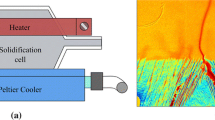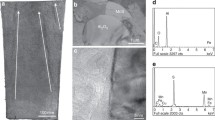Abstract
Conditions for the formation of macroscopic segregation channels have been examined in the ammonium chloride-water and lead-tin systems, using base chilled molds. Such channels develop when the rejected solute is less dense than the solvent and are therefore a result of density inversion, but slow (≺5 rpm) rates of mold rotation, about axes inclined to the vertical by 20 deg to 30 deg, throughout the time of solidification, effectively prevent the formation or propagation of these channels. Artificially created channels or those momentarily blocked fail to continue and are overgrown, but channels can be initiated by drawing liquid upward from close to the growth front in fine capillaries. Examination of these effects leads to the conclusion that channels originate at the growth front, rather than within the dendritic array, and that their formation is necessarily preceded by a liquid perturbation from the less dense boundary layer into the supernatant, quiescent bulk liquid. Intermittent ‘solute fingers’ are then fed by dendritic entrainment to produce stable convective plumes and concomitant channels. It is considered that the effects of mold precession are primarily caused by translation of bulk liquid across the dendritic growth front, shearing off convective perturbations from the boundary layer before they have time to develop. The nature of the liquid movements is discussed and shown to be a function of the mold dimensions. The inclination of the gravitational vector within the solid-liquid, dendritic array is considered to be of secondary importance to the formation or prevention of channels.
Similar content being viewed by others
References
K. A. Jackson, J. D. Hunt, D. R. Uhlmann, and T. P. Seward : Trans. TMS-AIME. 1966, vol. 236.
R. J. McDonald and J. D. Hunt:Trans. TMS-AIME, 1969, vol. 245, p. 133.
R. J. McDonald and J. D. Hunt:Metall. Trans., 1970, vol. 1, p. 1787.
S.M. Copley, A. F. Giamei, S.M. Johnson, and M.F. Hombecker:Metall. Trans., 1970, vol. 1, p. 2193.
K.M. Fisher and J. D. Hunt:Sheffield International Conference on Solidification and Casting, Metals Society, 1977, book 193, p. 325.
B. E. Watts and P. C. Morgan: ECSC publication, # EUR 7723/IIIEN, 1982.
R. J. Schaefer and S. R. Coriell:Materials Processing in the Reduced Environment of Space, Elsevier Science Publishing Co. Inc., 1982, p. 479.
A.K. Sample and A. Hellawell:Metall. Trans. B, 1982, vol. 13B, p. 495.
R. Mehrabian, M. Keane, and M. C. Flemings:Metall. Trans., 1970, vol. 1, p. 1209 and p. 3238.
A. K. Sample and A. Hellawell:Modelling of Casting and Welding Processes II, TMS-AIME, 1984, p. 119.
S. Kou, D. R. Poirier, and M. C. Flemings:Metall. Trans. B, 1978, vol. 9B, p. 711.
J. S. Turner:Buoyancy Effects in Fluids, Cambridge University Press, London, 1973.
R.M. Sharp and A. Hellawell:J. Crystal Growth, 1972, vol. 12, p. 261.
S.R. Coriell, M. R. Cordes, W.J. Boettinger, and R. F. Sekerka:J. Crystal Growth, 1980, vol. 49, p. 13.
D.T.J. Hurle, E. Jakeman, and A.A. Wheeler.J. Crystal Growth, 1982, vol. 58, p. 163.
G. B. McFadden, R.G. Rehm, S.R. Coriell, W. Chuck, and K. A. Morrish: National Bureau of Standards, to be published.
R. N. Grugel, T. A. Lograsso, and A. Hellawell:Materials Processing in the Reduced Environment of Space, Elsevier Science Publishing Co., Inc., 1982, p. 553.
S.R. Coriell, G. B. McFadden, R. F. Boisvert, and R. F. Sekerka: National Bureau of Standards, to be published.
Author information
Authors and Affiliations
Additional information
This paper is based on a presentation made at the symposium “Fluid Flow at Solid-Liquid Interfaces” held at the fall meeting of the TMS-AIME in Philadelphia, PA on October 5, 1983 under the TMS-AIME Solidification Committee.
Rights and permissions
About this article
Cite this article
Sample, A.K., Hellawell, A. The mechanisms of formation and prevention of channel segregation during alloy solidification. Metall Trans A 15, 2163–2173 (1984). https://doi.org/10.1007/BF02647099
Issue Date:
DOI: https://doi.org/10.1007/BF02647099




